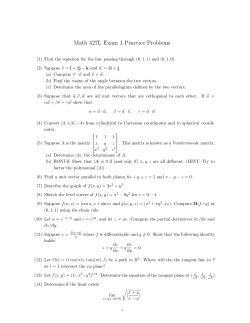
CHEM1102 Worksheet 7: Reactions of Carbonyls and Acid
CHEM1102 Worksheet 7: Reactions of Carbonyls and Acid Derivatives Model 1: Addition to a Carbonyl In Worksheet 2, you looked at the following reaction: The addition of a nucleophile to a carbonyl carbon is a very general reaction. The C=O bond is very polar and the C end is very easily attacked by a nucleophile. Critical thinking questions 1. Using the model above, predict the outcome of the following reactions. (Hint: LiAlH4 reacts as if it contains the hydride ion, H, and CH3CH2MgBr reacts as it contains the carbanion, CH3CH2) 2. Describe the products of the above reaction as (R), (S), racemic or achiral. 3. Do you expect aldehydes to be more or less electrophilic than the corresponding carboxylic acids? Explain. 4. Based on this, predict the outcome of the reaction below. Grignard reagents (RMgBr) are excellent nucleophiles, and are a very good way to form new carbon-carbon bonds. 5. Identify the appropriate Grignard reagent to complete the following reactions. Extension: In each case, the addition of the nucleophile was followed by addition of acid. What purpose does this serve? Why are they not added at the same time? Model 2: Carboxylic Acid Derivatives Carboxylic acid derivatives are formed from the condensation of a carboxylic acid with a second functional group, such as an alcohol or an amine. In some cases they can be formed directly. More often, the carboxylic acid must be converted to a more reactive intermediate, such as an acid chloride but the process of condensation is essentially the same: Critical thinking questions 1. Using the reaction above as a model, try to devise a mechanism for the condensation of an acid chloride with an amine to form an amide. Here are the common carboxylic acid derivatives, arranged from most reactive to least reactive. A carboxylic acid derivative can only be converted to form a more stable derivative. 2. How might you convert an ester into an amide? (Hint: look at your answer to Question 1). 3. What is the by-product of this reaction? Extension: By considering how the substituents will affect the partial charge on the carbon atom of the carbonyl group, explain the trend in reactivity of the derivatives shown above. 4. Carboxylic acids are, as the name suggests, capable of undergoing acid-base reactions. We also know that amines are basic. Use this to predict the outcome of the following reactions. The scheme below shows the condensation of a carboxylic acid and an alcohol to give an ester, followed by hydrolysis of the ester back to the carboxylic acid and alcohol. Hydrolysis can be catalysed by acid or base. 5. Overall, what is being removed or added in each step? How does this relate to the names we give these reactions (condensation and hydrolysis)? 6. Complete the schemes bellow. O H+(aq) OH 7. Cl An acid chloride can be hydrolysed using just water, whereas hydrolysis of an amide requires an acid (or base) and heat. Explain the origin of the difference. Now make yourself a revision summary sheet and / or flashcards to help you remember the key transformations studied in this course. This might include: alkenes and alkynes - electrophilic addition of HX to alkenes and alkynes (X = H, Cl, Br, I, OH) (including the prediction of the major product using Markovnikov’s rule), alcohols – acid/base reactions, oxidation reactions and acid catalysed elimination (including the prediction of the major product using Zaitsev’s rule). amines – acid/base reactions and use in substitution reactions, alkyl halides – use in substitution reactions and base catalysed elimination (including the prediction of the major product using Zaitsev’s rule) aldehydes and ketones – nucleophilic addition, reduction and oxidation carboxylic acid derivatives – acid/base reactions, nucleophilic substitution and reduction
© Copyright 2025















